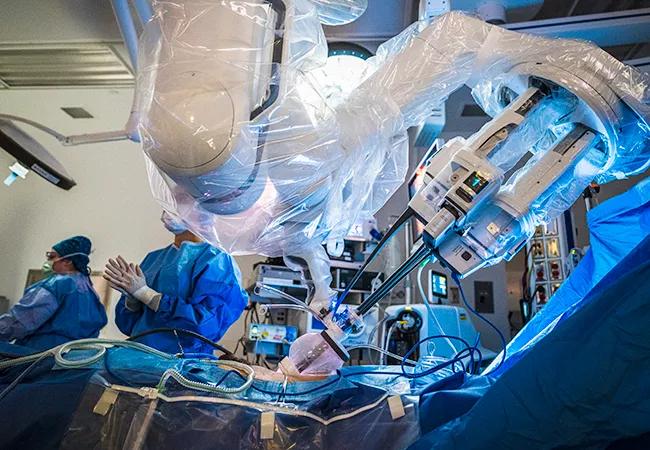Surgeons choreograph nearly simultaneous procedures, sharing one robot between two patients

For the first time, Cleveland Clinic surgeons orchestrated a nearly simultaneous robotic single-port (SP) kidney transplant procedure for a donor and recipient using one robot.
Advertisement
Cleveland Clinic is a non-profit academic medical center. Advertising on our site helps support our mission. We do not endorse non-Cleveland Clinic products or services. Policy
In 2019, Cleveland Clinic became the first in the world to perform an SP robotic-assisted kidney transplantation successfully. Now, a recent Cleveland Clinic case shows that with appropriate planning, coordination and attention to detail, both donor and recipient can benefit from the same SP robot.
Mohamed Eltemamy, MD, a member of both the Center for Robotic and Image-Guided Surgery and Center for Renal Transplantation at Cleveland Clinic, explains, “We’ve used the technology for donors; we’ve used it for recipients; and both benefit from an improved recovery and smaller incision. So, why not try it for both in the same procedure?”
Dr. Eltemamy led the recipient portion of the surgery, while Alvin Wee, MD, MBA, Director of Renal Transplantation at Cleveland Clinic, performed the living donor surgery.
The challenge with using the SP approach, which has become a preferred method at Cleveland Clinic, is that most donor and recipient surgeries occur nearly simultaneously, making access to and availability of the SP robot problematic. Most centers, including Cleveland Clinic, have only one SP robot. As such, coordinating the SP kidney transplant in both a donor and a recipient has remained an underexplored option — until now.
“As we’ve continued to fine-tune our experience over the years, there has been this question of ‘Why can’t we focus these efforts on donors as well?’” says Dr. Eltemamy. “These are healthy individuals, and providing them with a cosmetic advantage is a big plus.”
Advertisement
The cosmesis to which he refers is the difference between the standard laparoscopic approach, which requires four to five small incisions, compared to the one small incision concealed by the belly button when using the SP robot.
While surgical evolution is innate to the field, the team at Cleveland Clinic is quick to innovate and adopt new practices. Dr. Wee points out that 20 years ago, laparoscopic donor nephrectomy was a controversial alternative to open surgery, and now it has become the standard.
“We are always asking, ‘Can we do better? Can our patients experience less pain or have fewer postoperative issues?” he says.
Because there is a need to prepare the kidney following kidney explant, there is already a natural stagger in donor-recipient cases, allowing for the SP robot to be integrated into the surgical workflow. The team began a delayed start for the recipient transplant years ago to eliminate the recipient’s unnecessary wait time under anesthesia.
“It’s actually a great example of OR efficiency,” says Dr. Eltemamy. “Once the kidney is out from the donor site, it takes about 35 minutes to complete the preparation of the kidney. This is the perfect window of time to relocate the robot and use it to perform the initial work on the recipient prior to kidney arrival.”
Still, executing the details of a two-person surgery is more technically challenging. Dr. Wee compares it to choreography.
“It has to be well timed so that you minimize the procedure time and avoid having one person under anesthesia for too long,” says Dr. Wee.
Advertisement
While the surgeons agree the technique offers a cosmetic advantage, more evidence is needed to determine if it’s superior to laparoscopic nephrectomy regarding improved pain scores and postoperative outcomes. With this case completed, the team plans to continue refining the approach and offering it to more donors and recipients in the coming year.
Advertisement
Advertisement

Enhanced visualization and dexterity enable safer, more precise procedures and lead to better patient outcomes

Insights on bringing Cleveland Clinic even closer to becoming the best transplant enterprise in the world

Consensus statement aims to increase use of the perfusion technology and raise transplant volumes

Minimally invasive approach, peri- and postoperative protocols reduce risk and recovery time for these rare, magnanimous two-time donors

Minimally invasive pancreas-kidney replacement reduces patient’s pain, expedites recovery

Largest study to date confirms mortality rates similar to DBD transplant and reveals risk factors

Patient receives liver transplant and a new lease on life

More than 30% of patients die when early dialysis is needed after surgery